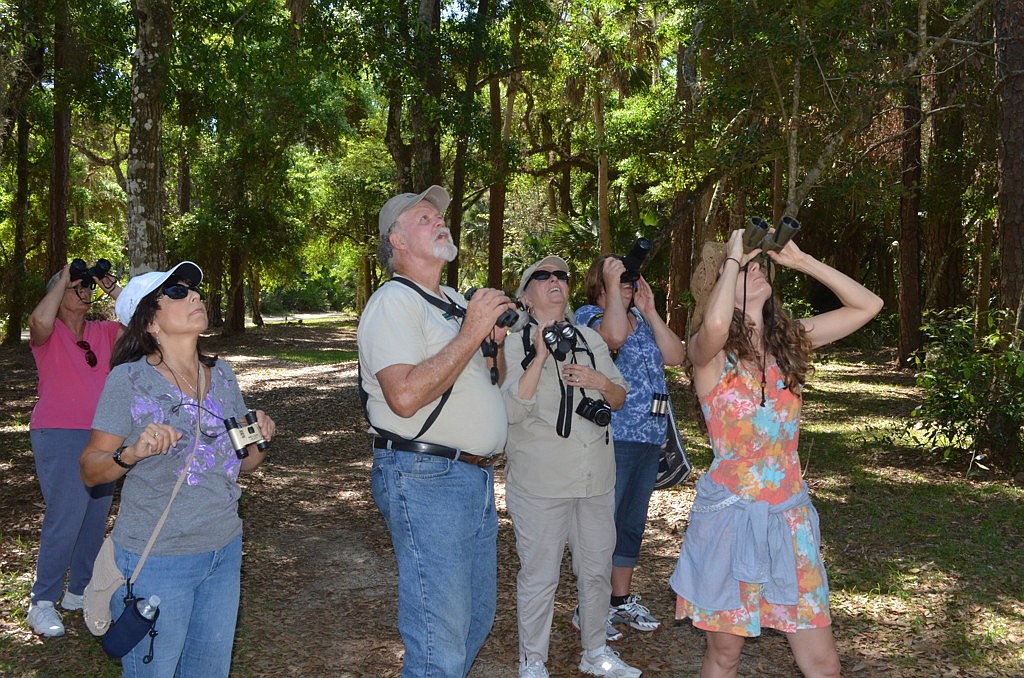- April 19, 2024
-
-
Loading

Loading

A cool breeze was blowing and mosquitoes had not yet reported for duty.
Wayne Grant
Staff Writer
Before David Smith moved from Scotland to Florida a year ago, he had no idea there were places like Tomoka State Park, where you can go camping and birdwatching.
“We thought there were just beaches and Disneyworld, and inland was just swamps with a lot of strange people,” he said April 4 at the park.
Smith and his wife, Dana Hargrove, who now live in Orlando, joined about a dozen others for the “All About Birds” program at the park. Representatives of Halifax Audubon were there to talk about, you guessed it, birds, along with migration habits and photography.
Smith said they were traveling to parks all over Florida, and were surprised to see so few people in the natural places.
His interest in the parks made me realize locals should appreciate them more. That’s why it was good to get to the park on a near-perfect spring day. A cool breeze was blowing in off the deep-blue Tomoka basin. Mosquitoes had not yet reported for their summer tour of duty. It was a good day to use bird watching as an excuse to wander through the hammocks and along the shore.
People gliding along the water on paddle boards reported seeing dolphins and manatees. Others were fishing from the shore or setting out in motor boats.
Having once been a “birder,” I looked forward to the outing. I slathered on suntan lotion and then sprayed for bugs, wondering briefly what chemical reaction the two compounds might have when mixed.
Then, over my neck went a hat with strap, binoculars and camera. I had to remember the order I put them on so I could take them off the same way. More than once, I’ve gotten straps tangled up and nearly hanged myself.
Leading the walk was David Hartgrove, conservation chair of Halifax Audubon, who shared his extensive knowledge.
For example, woodpeckers loudly rap on the metal caps on telephone poles on purpose, because it rings throughout the neighborhood and claims their territory. It’s one interesting fact after the other with birds.
I told him about my experience with birding, how I got interested on the beachside where birds are easily seen, and then found it quite challenging when trying to spot them in the leafy trees.
He explained that’s why you learn the field marks, such as a band over the eye or the shape of the wing.
“After a while you can recognize them driving down the road at 70 mph,” he said.
It’s this challenge that intrigues birders.
“It’s a bit of a puzzle to solve,” Smith explained. Keeping a list in a notebook of his sightings, he compared it to a “collecting” hobby.
Also on the trip was nature photographer Dan Gribbin. He showed me a photo of a royal tern making a ballet-like move before diving into the ocean. It was a moment in time you normally don’t get to see.
I showed him a photo I took the day before of a grackle taking a sip of water from an outdoor shower. I felt rather proud when he asked with interest, “Where did you take that?”
But then he pointed out that there two types of grackles, distinguished by the color of their eye, reminding me of the challenge of birding and my extreme amateur status.
Also along on the adventure was Robilee Leedy, a snowbird who travels in a camper to state parks throughout Florida.
She said they call their travel trailer their “Florida apartment.”
“The park system is fantastic,” she said.
Andrea Pair, of Daytona Beach Shores, said she got into birding because she wanted to take photographs, and birds were a good subject.
“I started with lighthouses but they are few and far between,” she said.
Giving a presentation was Meret Wilson, of Ormond Beach. A longtime park volunteer, she has been catching and banding birds for 10 years. She also makes surveys and reports her findings to the park service.
Bird banding is used to keep track of birds as they move about the country.
Wilson said over the years she has banded 5,000 birds. She catches them in a soft net mounted between trees.
She said she has the entire park to roam to watch for birds, but even a small yard can be a great place for bird watching, if food and water is available. She has flowers, bird feeders and especially bird baths in her yard.
“Everything needs a drink when it gets this warm,” she said.